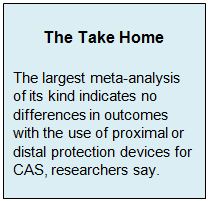Key Points:
- Meta-analysis reviews outcomes for CAS with proximal vs distal protection
- Most outcome similar; trends seen toward reduced stroke, mortality with proximal protection
The use of proximal and distal protection devices for carotid artery stenting (CAS) results in equivalent outcomes, according to a meta-analysis presented on Tuesday, October 13, at the 2015 Transcatheter Cardiovascular Therapeutics meeting in San Francisco, CA.
Researchers led by Jad Omran MD, of the University of Missouri-Columbia (Columbia, MO), and Ashraf S. Al-Dadah, MD, of Prairie Cardiovascular Consultants, Ltd (Springfield, IL), used random-effects modeling to pool outcomes across studies that compared distal and proximal embolic protection devices for CAS. Overall, 12,281 patients (mean age 69 years; 64% men) were included from 13 prospective and 5 retrospective studies published between January 1998 and May 2015.
No significant differences were detected between the use of distal and proximal protection with regard to the primary endpoints of stroke and mortality (risk difference 0.0; 95% CI -0.01 to 0.01 for both). There also was no difference in the incidence of new cerebral lesions on DW-MRI, contralateral DW-MRI lesions, TIA or ICA spasm.
Trend Towards Better Outcomes with Proximal Protection
“The standard of care [for the treatment of CAS] is the use of either distal filter protection or proximal balloon occlusion, [but] to date the data in support of either strategy are conflicting and inconclusive,” Drs. Omran and Al-Dadah told WLNCMD in an email While this meta-analysis—which they say is the largest of its kind—found no significant difference between the 2 modalities with respect to multiple outcomes, “there was a numerical trend favoring the proximal balloon occlusion device in terms of mortality and stroke incidence.”
“Most of these studies were not powered enough to make a full statement regarding which device is better,” Drs. Omran and Al-Dadah said. “[O]perator's expedience and the level of comfort make the biggest impact on selection of the type of protection device, which in several studies [has shown] lower complication rates at high-volume centers.”
The Mo.Ma proximal cerebral protection device (Medtronic) has an intuitive advantage, Thomas Maldonado, MD, of NYU Langone Medical Center (New York, NY), told WLNCMD in a telephone interview. “The advantage of the Mo.Ma device is that, in theory, one does not have to cross the lesion and therefore the very moment which places the patient at increased risk, when the filter wire crosses the lesion unprotected, does not occur,” he explained, noting that it is a little surprising no statistically significant benefits were seen with proximal protection in this meta-analysis.
“Proximal protection is a little more cumbersome and daunting of a technique and has a learning curve,” he said. “There are also some limitations in that not all patients tolerate proximal protection because not all are clamp tolerant. … If there were a marked statistically significant benefit, it might cause people to use proximal protection, but these studies don’t appear to bear that out. But intuitively it makes a lot of sense that you would have less risk of embolic complications when using a protection device that never crosses the lesion, as is true with the proximal protection device.”
Given the inherent limitations of a meta-analysis, Dr. Maldonado said, the relative benefits of each approach should be evaluated in a randomized controlled trial. This approach could help determine whether the trend toward improved outcomes with proximal protection reflects a true advantage.
Source:
Omran J, Abdullah O, Firwana B et al. Proximal balloon occlusion versus distal filter protection in carotid artery stenting: A meta-analysis of clinical trial data. Presented at: TCT 2015; October, 13, 2015; San Francisco, CA.
Disclosures:
- Drs. Al-Dadah, Maldonado, and Omran report no relevant conflicts of interest.


